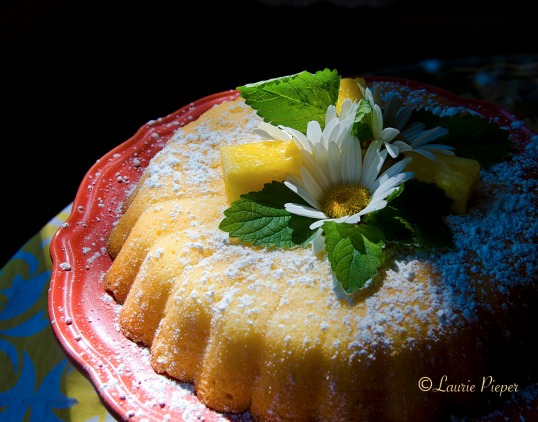Fresh Pineapple Cake
This is a very light, moist cake with a coarse crumb that is not overly sweet. Serve for breakfast with fresh fruit and yogurt or for afternoon tea.
1 1/2 c. all-purpose flour or white rice flour (for gluten-free)
1 t. baking powder
1/4 t. salt
1 stick unsalted butter, softened
3/4 c. granulated white sugar
2 lg. eggs
1 c. buttermilk or whole milk
3/4 c. fresh pineapple cubes (between the size of raspberries and blueberries)*
confectioner’s sugar for garnish
edible flowers**, herbs, fresh pineapple for garnish, optional
1. Preheat the oven to 325 degrees F. Prepare an 8″ round cake pan or decorative cake pan with baking spray or with butter and flour. (For gluten-free, use rice flour.)
2. In a small bowl, whisk together flour, baking powder and salt. Set aside.
3. In a medium bowl, beat butter until it is light and fluffy. Add granulated sugar and continue to beat for about 5 minutes or until the mixture is light and fluffy. Scrape sides of bowl. Add eggs, one at a time, beating well after each addition. Scrape sides of bowl.
4. Lightly beat in 1/3 of flour mixture, then 1/2 c. of buttermilk or milk. Scrape sides of bowl. Repeat, and then beat in the remaining flour mixture.
5. Fold pineapple into batter. Spoon batter into the prepared cake pan, using the back of the spoon to smooth and level top of batter.
6. Bake for about 40 minutes or until a cake tester inserted into the center tests clean.
7. Cool cake in pan on a wire rack for 10 minutes. Invert cake onto cake plate to serve right away or onto wire rack to continue cooling. Dust the cake with confectioner’s sugar before serving. Garnish as desired.
* Canned pineapple tidbits can be substituted in the recipe for fresh pineapple, if well-drained first.
** Daisies and lemon balm leaves are shown here. Daisies are edible and taste similar to parsley. So they are not very dessert-like in flavor, but they are a pretty garnish.
Enjoy!






